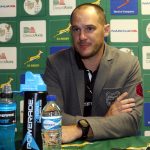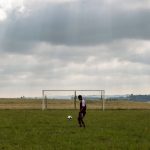The new football champions of Stellenbosch
The rugby-mad town with a chequered history has new heroes. This time the ball is round and the joyful noise of triumph comes from a part of Stellenboch that’s on the fringes, figuratively and lite…
Author:
29 July 2019

Stellenbosch never strays far from the glare of public conversation. The university town, as many meekly refer to it, has a legacy of questionable and laudable achievements in the chequered history of the divided Western Cape. Though there is little restraint shown in celebrating the Winelands’ sprawling vineyards, manicured estates and impressive art galleries, in true South African fashion it has a complicated past and a complex, indistinguishable future.
In sporting terms, the heart of Stellenbosch has always belonged to rugby. Pride passes down the line, from generation to generation, and imposes itself on anyone connected to its crown jewel, Stellenbosch University. The legend of players such as Danie Craven and Paul Roos lives strong in these parts and for those too young to care, the university’s rugby team, the Maties, has enabled similar levels of camaraderie and loyalty – annihilating all before them in the Varsity Cup.
But lately the joyful noise of triumph has carried from a different point of origin – out in Idasvallei, Cloetesville and Kayamandi across the R310 and the R304 – on the fringes of Stellenbosch, figuratively and literally. Here the jerseys are still Maties maroon and the passion runs as deep and true, but the ball is round and the game attracts a football support base at Idas Valley Stadium that can challenge numbers at the Danie Craven stronghold.
Related article:
The cheers are the anthem of accomplishment orchestrated by the Stellenbosch FC faithful. They support a football club that has evolved overnight and entered the glamorous world of the elite league. It has been a whirlwind romance and the club’s ascension to the elite league of South African football is the very definition of an overnight success. It feels too good to be true sometimes.
Stellenbosch FC was formed in 2016, when Vasco da Gama changed its name and moved from Parow to the Stellenbosch Academy of Sport (SAS). The institute, owned by Remgro, eventually bought Stellenbosch FC outright and in less than three years of existence, the club finds itself in the elite league.
With the SAS’s state-of-the-art facilities at hand, the club set about rewriting a case study for football success in South Africa by ensuring the team received the best developmental support, from nutrition to physical conditioning and accommodation. Among other things, the SAS boasts “access to leading sport scientists, doctors, coaches, physiotherapists and biokineticists and performance-nutrition catering”.
International athletes descend on the SAS for critical training and conditioning before big competitions.
Another fairytale in the Premier Division?
No one is more acutely aware of the benefits of such a system than Stellenbosch FC’s star player and top goal scorer Iqraam Rayners. The 23-year-old’s 19 goals were key for Stellies in a tightly contested National First Division (NFD) season.
If Rayners can somehow get close to that tally in the Absa Premiership season, which starts for the Western Cape side against Chippa United on 3 August, it would put him among the best strikers in the country. A fairy tale, maybe. But so is Stellenbosch’s story sometimes, although the club and Rayners seem to have the right balance of realism and optimism.
Born in Valhalla Park, Rayners and his family moved to Mitchell’s Plain in 2007, before he entered his teens. As with too many teenage lives on the Cape Flats and the fringes of poor communities, gangsterism and its accompanying ills were a life-changing diversion for Rayners. It caused him to drop out of school before completing matric.
Related article:
“It was a bit of a rough time, and there was a lot going on. I was young. Luckily, I got involved in football when I was in high school. When I was about 15 or 16, I went for a trial at Santos and I was given the opportunity to play for the Under-17 team. After that, I signed a contract with Santos in the NFD,” Rayners says.
He soon caught the eye of Stellenbosch FC coach Steve Barker, who invited him for a trial. “After two or three days, I was offered a contract.”
Barker’s coaching philosophy has been positive reinforcement, accompanied by hard work on the practice field and in the gym.
The secret to the club’s success
“Every day when you’re done with training, you can do some extra work in the gym or you can go to the field any time, so it was nice. Whenever guys are injured, it’s just like a week or so and then they’re back. They look after the players at SAS. It’s been good working with a coach like Steve who is consistently telling the players they’re doing well and advising us what we must do this week. It’s important to play in an environment like that,” Rayners said.
Stellenbosch’s success has been built around a core team of experienced NFD players like Rayners, Mogamad de Goede, Lee-Raoul Langeveldt, Nkanyiso Zungu, Gregory Roelf and captain Jarrod Moroole – all loyal to the cause and with more than 600 caps in the second tier between them. It is this strength and depth that saw Stellies through the dark days towards the end of their winning campaign, as the Royal Eagles closed in on them with three straight wins.
“Towards the end of the season we had a lot of away games, so we didn’t have it all our own way. We believed in ourselves, that we needed to bounce back. That was our philosophy, never give up,” said Rayners.
Related article:
Being based in Stellenbosch has allowed players like Rayners to achieve the type of success that is unlikely for many in the communities the players represent. They are the shining examples in a region that is still largely divided along lines of race and class.
Writing in the Mail & Guardian in May 2014, Nic Spaull, an economics researcher based at Stellenbosch University, pointed out that “between 1919 and 1978, every single prime minister of our country hailed from Stellenbosch University – Jan Smuts, JBM Hertzog, Malan, JG Strijdom, Verwoerd and BJ Vorster – whether as students, professors or chancellors. They then went on to become the architects and implementers of the oppressive apartheid regime of legislated racial exclusivity.”
Fast forward to 2019 and the publication of a “study” on the cognitive skills of those categorised as coloured by the apartheid government that painted them out to be uneducated and unhealthy. Unsurprisingly, an apologetic Stellenbosch University retracted the study and an investigation was launched.
Busting a number of myths
These grim episodes remain as stains on Stellenbosch’s colourful and larger-than-life story, even as the town tries to drag itself into a more inclusive future by using narratives like Stellenbosch FC’s magical ascent as a catalyst for social change.
The idea of such renewal seems a stretch, or at best a poorly scripted B-grade sports movie, given how deep the chasm is between rich and poor in Stellenbosch. But there is no better story in town right now.
Stellenbosch FC is a success story that busts various myths about progress and success. For one thing, the myth that success takes time. Stellies took three years from being established to winning promotion into the big league, something others have failed for decades to do.
Related article:
To be fair, the region has a rich history of football in working-class areas, from which Stellies draws its strength. Feverish home support on and off the field has been a key ingredient in the club’s success and will be a feature of its debut season in top-flight football. The strategy is certainly to keep the team close to its support base in Idasvallei and surrounding areas.
“Every week, the stadium is full and the people come out and support their team. And now that we are playing in Idas Valley, it’s a good feeling. Last season we had to travel to Athlone Stadium, which was not good because we would only get like 15 people coming to support us at the match,” Rayners explains.
The other myth is that money can’t buy success. It can, if that money is channelled into development players and unearthing talent instead of paying overpriced managers with recycled ideas. And this is where Stellenbosch FC’s owners come into play. Johann Rupert, the fourth-wealthiest man in South Africa, chairs the Remgro-owned SAS.
Local football is new territory for the Rupert empire, but wealthy and powerful owners are nothing new to the beautiful game.
More than a football club
Remgro boasts a 50% interest in the Blue Bulls rugby franchise and, up until last year, a significant portion of Saracens rugby club in the United Kingdom. Its control of Stellenbosch FC through its 100% ownership of the SAS could put the football club on a growth trajectory unlike any before in the South African context.
Billionaire businessman Patrice Motsepe’s purchase of Sundowns came at a time when Mamelodi Sundowns were already successful. Rupert and the SAS have pitched the Stellenbosch FC project as more than a football club, it is an agent of change with a social investment strategy.
“The vision is much greater than being a successful professional football club. It is to make a meaningful difference in the community, to create opportunities and dreams that might have seemed unrealistic before our young people. It will take time, but I am very excited about the possibilities this venture holds,” Remgro chief executive Jannie Durand said when the club was launched.
“In South Africa, football enjoys unrivalled support and popularity and therefore is a powerful medium to uplift communities and provide hope and inspiration,” said Stellenbosch FC chief executive Rob Benadie.
Related article:
“The professional team is the inspirational and reference point for the dream and pathway we aim to build for young footballers in the area. Until now, young players in the Stellenbosch and Winelands area only dreamed of playing for Chiefs or Pirates in Johannesburg and had to join the likes of Ajax Cape Town based in Parow if they wanted to further their football careers. Now there is a local team, owned by a local business with the vision of building a successful homegrown team that the local communities can be proud of.”
A season in the Premier Soccer League presents new challenges for Barker and his team. Should he get the backing from the SAS and Remgro, he may be able to dig deep into his pockets to enhance his squad. That financial muscle has to work overtime to ensure that the club gets to play in Stellenbosch some time this season as their preferred venue, Idas Valley, was deemed not good enough for Premier Division matches, which will force them to use Athlone Stadium for their early home matches.
“We are going to have to beef up our squad, factoring in our obligation to field a team in the Multichoice Diski Challenge,” Barker said. “But we will not turn our backs on the players who got us into the position we are. A player like Iqraam scored 30 goals in two seasons and is headed for higher honours. He’s going to be massive for us when we come face to face with the big boys,” Barker said. “After all, we are about promoting young talent from the Winelands region, and we have that in abundance.”





